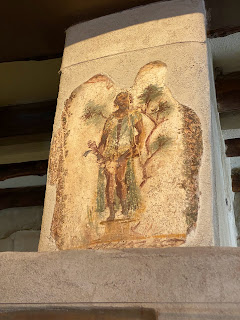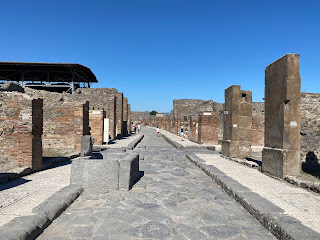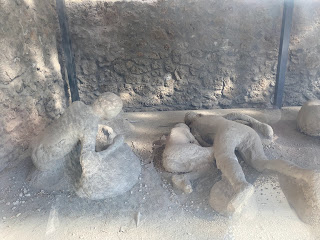We weren't in Rome long but we hit it very hard yesterday and I was satisfied with our accomplishments.
We drove under one last aqueduct as we waved goodbye to the ancient city.
We stopped at what felt like a pretty upscale gas station compared to most.
They had a "local products" section that I bought this fancy apple cider and some lemon and pistachio flavored cantucci. So in Italian biscotti just means "cookies", and so then cantucci is what Italians call the cookies that we call biscotti: the hard crunchy dried bread type deals.
We looped around Naples to visit its much less populated neighbor: Pompeii.
We killed a bit of time in the touristy area outside the gates to Pompeii.
Naples is famous for pizza so why not?
Some of the juice stands had normal lemons then massive monster lemons.
Nearby Mount Vesuvius erupted in 79 CE and buried Pompeii and its inhabitants in ash and rock. It didn't begin to be unearthed until the 1700s which is crazy to me. The cool thing is that since the city was evacuated in a hurry, we've learned a lot about normal people's lives. For example there were still loaves of bread in bakery ovens.
Our guide said that this shade of red is so common here that Italians refer to it simply as "Pompeii red" when using it in modern day applications.
It was still hot and I was still hiding in the shadows like a cockroach fighting for his life.
I was surprised by the sophistication of the roads. They were graded and had good gutter systems to get the water off of them and away. They even had white stone in them in certain place which was meant to catch the light and make it easier to see at night.
We saw archaeologists actively wheelbarrowing dirt around. I think that if I was a rich person looking for a cool way to volunteer I would try to work at a Pompeii dig. I really liked how you could learn so much about average Romans here. Rome is full of grand architectural wonders like the Colosseum but here you could just see a normal person's house and think about the similarities between their life and your own.
I think the point here was that because a lot of people were illiterate that the streets were marked with pictures to help people navigate.
This cave canem "beware of dog" mosaic in the entryway of someone's house was a big reminder of how some things haven't changed much in 2000 years.
This was another fun and unexpected road innovation. The raised stone portions are like a little stepping stone bridges for people to walk across and not have to step in the dirty street. The gaps are where wagon wheels can cross through the other direction. Pretty smart!
Welcome mat
They had some of the ancient fountains still operating, which was nice because it was very hot and I was very thirsty.
I want to say this was a bakery.
These little places were all over the place. It was sort of like a fast food restaurant. There were clay pots set into a counter for easy access.
We saw the Stabian Baths that were both beautiful and technologically impressive. The oldest and the largest of the 5 public baths in the city, their original construction dates back to ca. 125 BC, making them one of the oldest bathing complexes known from the ancient world.
The place was amazingly decorated.
The frigidarium was where Romans could swim in cold water.
I think those square holes in the walls were for people to put their clothes. Like little lockers.
This system of central heating is called a hypocaust. You could see where a raised floor was installed, then they would have hot air flowing underneath providing the heat for the baths. I think this is the first time I've seen or heard of Romans having this kind of technology and I was really impressed.
There were several castings of people that didn't make it out of the disaster alive. This woman was probably a slave because of the belt she had on.
Not too far from the baths to get clean was the Lupanar of Pompeii where one could get dirty again. The Roman word for brothel was lupanar, meaning a wolf den, and a prostitute was called a lupa ("she-wolf").This was the only place I saw these stone beds. They may have been purposefully uncomfortable so that people wouldn't try to actually sleep on them.
There were various... acts depicted on the walls that were for sale. This may have been a menu of sorts.
I wish there had been more explanation around to tell me what the graffiti/signage on some of the walls was talking about.
This was the most intact fast food place that we saw. There was still some decoration on the walls.
There were also these holes drilled into the counter that they theorize were there to identify different coins that were in use. To me they look like one of those coin collector things that used to be in the console of your car to keep change in, or like that old timey bus drivers used to carry to dispense coins.
[-----]NCTIVS C∙ F∙ VALGVS
[-----]CIVS M∙ F∙ DVO∙VIR
[-----] COLONIAI∙HONORIS
[------]∙SPECTACVLA∙DE∙SVA
[------] COER∙ET∙COLONEIS
[----]M∙IN∙PERPETVOM∙DEDER
Caius Quinctius Valgus, son of Gaius, (and) Marcus Porcius, son of Marcus, quinquennial duumvirs, for the sake of the honour of the colony undertook the construction of the amphitheatre at their own expense and they gave the area to the colonists in perpetuity.
I thought it was fun that at the time they weren't using "amphitheatre" but spectacula.
Are you not entertained?! I'm quite a spectacle.
The museum areas were very cool but they gave me a little bit of sadness. I wish I could see all of these objects out where they were found in order to give the place more life. I want to see this loaf of bread back on the fast food counter waiting for someone to buy it.
These guys pretty much ate the same things as I do: peaches, figs, almonds, and walnuts.
This was some beautiful wall covering that again I wish they could have left where they found it.
"Medallion depicting Maenad and a young Satyr holding a silver drinking cup for wine."
In Greek mythology, maenads were the female followers of Dionysus and the most significant members of the Thiasus, the god's retinue. Their name literally translates as "raving ones". Often the maenads were portrayed as inspired by Dionysus into a state of ecstatic frenzy through a combination of dancing and intoxication.
Satyr and hermaphrodite
We hit a grocery store on the way out of town and I was excited about the available range of bitter chino fruit flavored soft drinks.
We spent the night in Salerno. We checked out the local mall but I was disappointed because a lot of it was the same boring malls brands I'm familiar with. We couldn't find a cab to take us back to the airbnb so we took a very long walk back home in the dark instead.
Nobody does construction like Italian ants.

































































































No comments:
Post a Comment